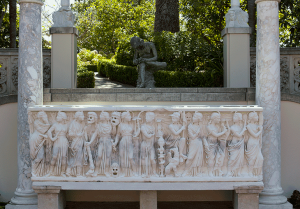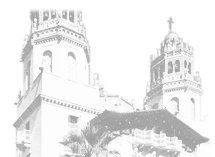 Marble
Marble
Roman, about 230 A.D.
The sarcophagus depicts the deceased in the center as the god Apollo with his lyre. Minerva, wearing armor as the goddess of righteous warfare, stands next to him. They are flanked by the nine Muses, minor deities who were the daughters of Jupiter. In ancient Greek and Roman mythology, they inspired poetry, song, and other arts. They are identified by the attributes that they hold. From left to right, the Muses are: Polyhymnia (sacred hymns), Euterpe (lyric poetry), Thalia (comedy), Melpomene (tragedy), Erato (love poetry), Minerva (goddess of wisdom), Calliope (epic poetry), Terpsichore (dance and choral song), Urania (astronomy), and Clio (history). This sarcophagus is one of three ancient Roman works of art at Hearst Castle which were known in the Renaissance. It came from the renowned Maffei collection in Rome. One side of the sarcophagus was destroyed; it has been replaced here by a resin copy.


